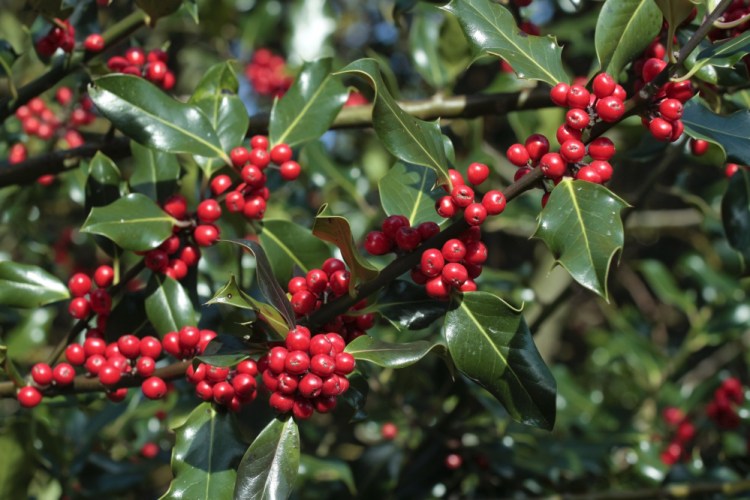Holly comes to the forefront of the landscape at this time of the year because its berries are bright – usually, but not always, red – when the rest of the landscape is green, at best, or drab.
Among the first shrubs we planted in our backyard about 40 years ago were two tiny Blue Princess and one even smaller Blue Prince holly bushes – and although no longer small, they still grow today. These, with the botanical name Ilex meserveae, are what most of us think of when we picture hollies in northern areas of the United States.
We cut them for Christmas wreaths and arrangements, enjoying the bright berries and glossy green foliage that has hints of blue (which explains the name).
Although I love these shrubs, they aren’t native to Maine. In fact, they aren’t native anywhere.
Up until shortly after World War II, the holly used for Christmas decorations was English holly, a Zone 7 plant that can’t survive anywhere in Maine. Florists imported cut holly, mostly from the Pacific Northwest, to sell in colder regions.
Kathleen K. Meserve, whose formal study of botany ended in the fifth grade, created the Zone 5 Meserve holly hybrids in her Long Island, New York, kitchen after attending a garden club lecture on hollies, according to her fascinating New York Times obituary. She crossed the English holly (Ilex aquifolium), with a low-growing native of northern Japan (Ilex rugosa).
Other Meserve hybrids are in the marketplace, and we did no research when we picked out Blue Prince and Princess, but we are pleased with our choice and they were Cary Award winners a couple of decades after we planted ours.
We prune them each year in December, both for Christmas decorations and to give away. We’d have to prune them sometime, anyway, because their ultimate heights are 10 feet for the Prince and six feet for the Princess, both larger than we want for the spots where they grow.
Why do we have both Prince and Princess? As is true with most hollies, the female hollies need a male nearby for pollination purposes to produce berries. You need only one male for many females, and the Prince will pollinate all Meserve-hybrid females.
Meserve hollies aren’t fussy about growing conditions. They prefer slightly acid soil and full or partial sun. But they are fairly drought tolerant and will put up with almost any condition. Deer will eat them, however.
As my wife, Nancy, and I have grown more concerned about growing natives, we have also added winterberry (Ilex verticillata) to our landscape. This shrub grows in the wild all over Maine, often in ditches or boggy areas along the roadsides. It is hardy to Zone 3, and while it likes boggy spring conditions in the wild, winterberries will thrive in typical garden conditions as long as you water them regularly during their first year of growth. Winterberries are even drought-tolerant once established.
Winterberries are deciduous, meaning that they drop their leaves in late fall, so while Meserve hollies provide contrasting red and green at this time of year, winterberries have bright red berries on bare stems.
Winterberries also require both male and female plants to produce berries, so be sure you pick up at least one male – Southern Gentleman and Jim Dandy are common cultivars – when buying the females.
While wildlife will eat the berries from evergreen hollies, they really love winterberry fruit. According to the University of Maine Extension Bulletin 2571 on winterberries, more than 43 species of birds eat the berries.
A literary side note: Thoreau wrote about native mice climbing winterberry stalks to collect winterberries and carry them back to their burrows.
By the way, Ilex verticillata includes hybrids such as Winter Gold and Berry Heavy Gold that produce yellow berries.
Most Maine nurseries sell only cultivar plants of the native winterberry. To buy the species – which is better for wildlife – you need to order from specialty nurseries or grow it from seed; the seeds are available from the Wild Seed Project, but expect to wait years before they bloom and produce berries.
Ilex is a broad group of shrubs, with many others you might want to try in your garden. Inkberry (Ilex glabra) is native to the southern United States, although it is Zone 5 so will grow in coastal Maine. They are evergreen and look like boxwoods, so are often used in hedges. They produce white flowers and black berries.
Another Maine native, mountain holly, I didn’t know about until I started searching the extension website for information on winterberry. It isn’t in the ilex family – its botanical name is Nemopanthus mucronatus – but it does grow in the same places as winterberry. According to the extension bulletin, wildlife eat the mountain holly’s berries early in the fall, so keep in mind that it won’t provide the winter excitement of the other hollies I’ve mentioned.
But if you have enough room for a thicket, the animals would love it. Or you could mix winterberry and mountain holly, providing wildlife snacks for several months.
Tom Atwell is a freelance writer living and gardening in Cape Elizabeth. He can be contacted at 767-2297 or at: tomatwell@me.com
Send questions/comments to the editors.



Success. Please wait for the page to reload. If the page does not reload within 5 seconds, please refresh the page.
Enter your email and password to access comments.
Hi, to comment on stories you must . This profile is in addition to your subscription and website login.
Already have a commenting profile? .
Invalid username/password.
Please check your email to confirm and complete your registration.
Only subscribers are eligible to post comments. Please subscribe or login first for digital access. Here’s why.
Use the form below to reset your password. When you've submitted your account email, we will send an email with a reset code.